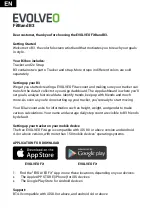
11
REPEATER
It may be required to have a duplicate console sited elsewhere, such as a control room or
instrument room.
Using the CAN network, 4 core (2 data + 2 supply) cable, a repeater can be connected which gives
a user interface identical to the main panel. In fact the data displayed on the repeater board is
transmitted from the main panel.
Likewise, button pushes on the repeater are transmitted to the main panel and are used by the main
panel as if they had been pressed locally.
To ensure the correct operation of the repeater, it has to be set up in order to accept CAN from a
main panel and also to know where to send its own CAN data. It is a requirement that the CAN2
bus is used for repeaters leaving CAN1 for sensors and other devices.
Sensors are able to use CAN2 at the same time as a repeater providing that the addresses are
different.
From power up or by pressing the processor reset button on the repeater and pressing the
SELECT
(3)
button at the same time the following sequence will occur on the LCD after releasing the select
button.
Set THIS ADDRESS using the
UP (1)
and
DOWN (5)
buttons to choose a free address that the
repeater will use as its own address. Note this has to be different from that of the main panel (which
defaults to address 201)
Press
SELECT (3)
Set FROM ADDRESS, this is the address of the main panel which will send LCD and LED data out to
this repeater to be displayed.
Press
SELECT (3)
, the two addresses will be stored.
The repeater is now awaiting data from the FROM ADDRESS and it will display an error if the panel
does not receive data for 30 seconds.
To initialise communication between the main panel and the Repeater panel return to the main
panel unit and follow the instructions in the Set up network controller section of this manual.
RS232 DATA LOG OUTPUT
In addition to Modbus, an additional data stream showing actions within the system is available via
the RS232 output.
This consists of a 3 wire interface which can connect directly into the serial port (RS232) connection
on a PC which is a 9 way D-type female connector (not supplied). This should be wired to the
system as follows.
D-type Pin
RS232 connector (Bottom left of PCB)
2
Tx
3
Rx
5
0V
Using Hyper-terminal on the PC set up at 2400 baud 8 bit no parity and no handshake,
the data output should appear on the screen and consists of any text which is being recorded in the
event log.













































